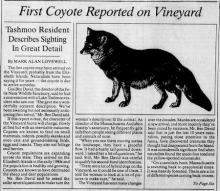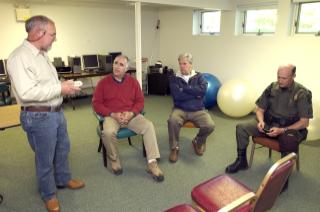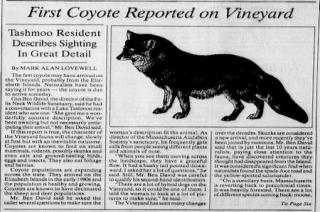Coyotes
2011
Island farmers were alarmed this week to learn of the possible presence of a visitor from the mainland: a coyote.
2010
If coyotes get a foothold on the Vineyard, the results could be disastrous, for farmers, landowners and the native wild animal population on the Island.
This was the somber message from Augustus Ben David 2nd, a former director of the Massachusetts Audubon Society’s Felix Neck Wildlife Sanctuary and one of the Island’s most respected naturalists, who spoke at a gathering at the Howes House on Monday.
There is at least one coyote living on Martha’s Vineyard. Gus Ben David is 100 per cent sure of that, although he has only 97 per cent proof.
The coyote, or coyotes, have established territory on the north side of the Island, in an area covering part of Chilmark and West Tisbury.
2004
A coyote, whose carcass was found on the North Shore last weekend, may have swum to the Island from the Elizabeth Islands.
That’s what Augustus Ben David, director of the Felix Neck Wildlife Sanctuary, is speculating.
The 40-pound, fully mature female adult coyote was discovered Sunday high up on the wrack line at Great Rock Bight in Chilmark by Tim Duys of Vineyard Haven. He delivered the carcass Tuesday to Felix Neck for examination.
Mr. Ben David said this is the first time any coyote has been spotted on the Island, either dead or alive.
1998
The first coyote may have arrived on the Vineyard, probably from the Elizabeth Islands. Naturalists have been saying it for years - the coyote is due to arrive someday.
Gus Ben David, the director of the Felix Neck Wildlife Sanctuary, said he had a conversation with a Lake Tashmoo resident who saw one. “She gave me a wonderfully accurate description. We’ve been awaiting but not necessarily anticipating their arrival,” Mr. Ben David said.
1993
Coyotes bring visions of the desert Southwest to mind, specifically of “Wile E. Coyote” chasing the “Road-runner” over rough terrain scattered with cactus. However, the reality of the situation is far different. Coyotes have, in fairly recent times, expanded their range. They are now distributed throughout New York and New England and are spreading southward. In the southern states they are expanding eastward. They are firmly established and regularly seen all over Cape Cod.






